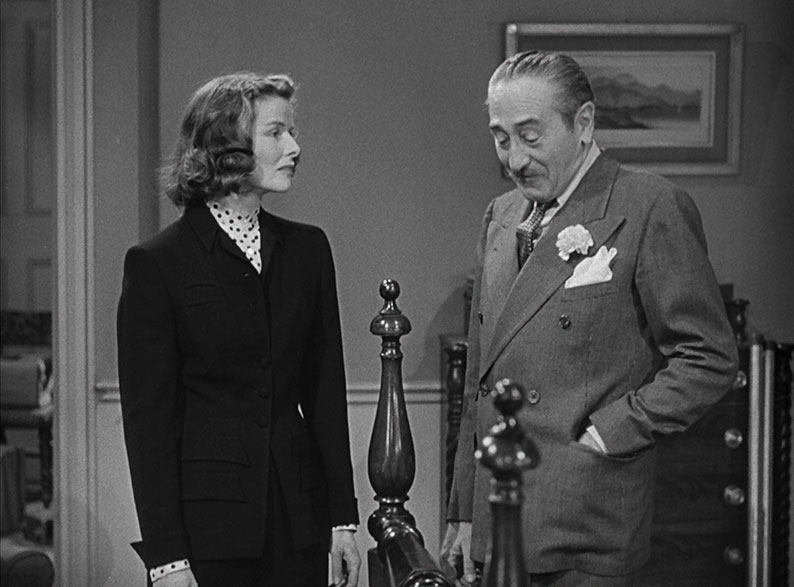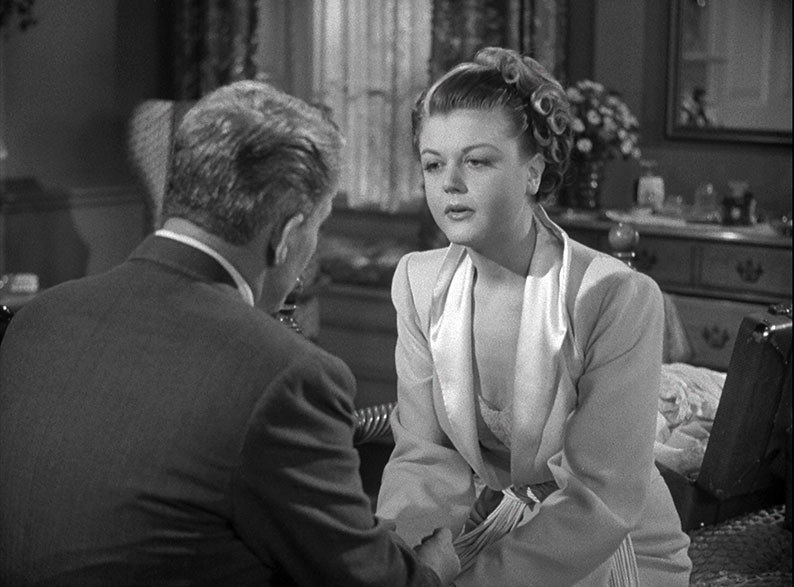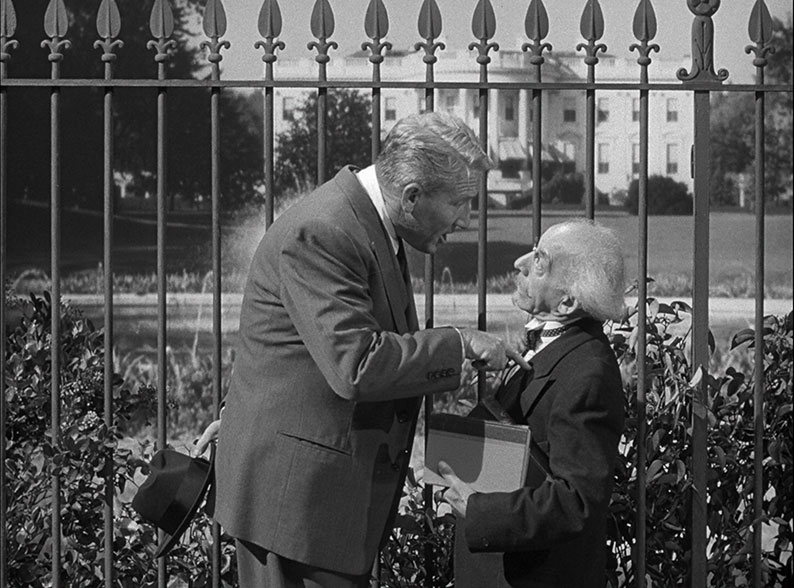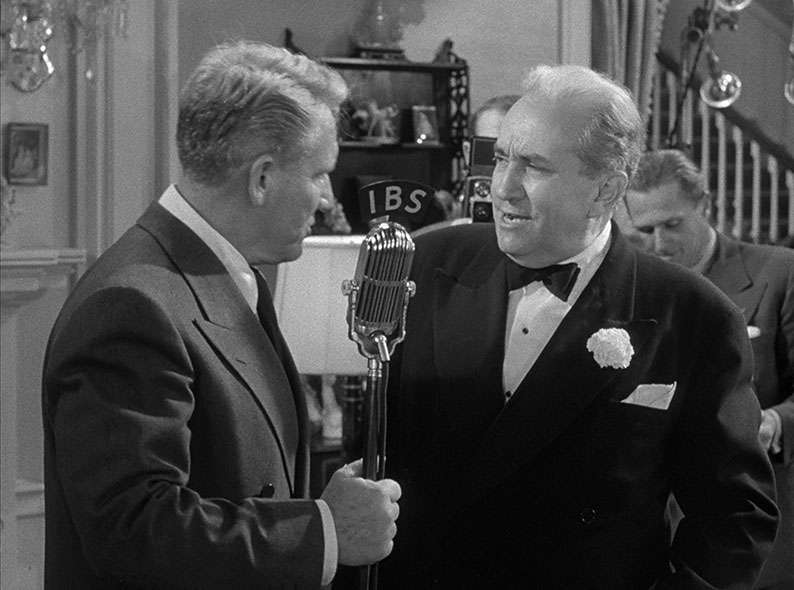|
It's 1948, in the run-up to the US presidential candidate. Newspaper magnate Kay Thorndyke (Angela Lansbury) plans to use her power to make Grant Matthews (Spencer Tracy) President by deadlocking the Republican National Convention and ensuring that he becomes the candidate. Secretly, Kay and Grant are lovers, though he is married to Mary (Katharine Hepburn), and it's planned to use Mary as part of the campaign.
All major artists, and film directors no different, have a peak period, and for Frank Capra it was the 1930s and 1940s. State of the Union, released in 1948, sits at the end of that period. Between 1950 and 1961, he directed six more features, two of which were remakes of earlier films of his, but none of them rank among his greatest work. Times were changing, and popular entertainment changes with those of society, and the type of films that Capra represented were drifting out of favour. There's also a hint of changing times in the film itself, which would affect the film industry: late on, we have a glimpse of the new and growing medium of television, including a 1948-era set, which may be one of the earliest uses of the small screen on the big screen.

State of the Union was the second and final production of Liberty Films, the independent company Capra jointly founded. The first was It's a Wonderful Life, two years earlier, a flop at the time for all that it's a Christmas perennial now. Liberty Films also had an involvement with I Remember Mama (directed by George Stevens in 1948) but was wound up in 1951. (This was Capra's second attempt at independence, Meet John Doe made by Frank Capra Productions in 1939 being the first. However, that company ended due to Capra's War service.) State of the Union was released in a few places (the UK and Australia among them) as The World and His Wife, losing the pun in the original title, the union not only referring to that of the United States and the marital union of Grant and Mary Matthews.
While there's certainly plenty of comedy in the film, including a scene near the halfway mark involving airplane acrobatics, State of the Union is as much a political drama, centring on the machinations around Grant as he positions himself as the Republican Presidential candidate. As the contemporary Monthly Film Bulletin reviewer (quoted in the booklet for this disc) says, some knowledge of the American political system is assumed in the script by Myles Connolly and Anthony Veiller (based on the 1945 play by Howard Lindsay and Russel Crouse, which won the Pulitzer Prize – the play was inspired by an idea of actress Helen Hayes), so one does wonder how well it did do overseas. However, the main points remain clear. If this film does show one thing, it's hard to imagine it being made nowadays, at least not about the current Republican Party, clearly much further to the right now than it was then. That said, some of the political comments the film puts into Grant's mouth veer from what would be traditionally Republican to more than verging on Democrat, even by the standards of the time. Grant's character is partly inspired by Wendell Wilkie, who had campaigned for President in the 1940 election, making much of his status as an "ordinary man" and who had begun as a Democrat before moving to the Republicans. Tracy and Hepburn were leading Hollywood Democrats, though Adolphe Menjou, further down the cast, was an ardent Republican and indeed involved in the Anti-Communist hearings in the next decade. The political mixed messages allow the film in a sense to have its cake and eat it: certainly centred on the Republicans (with a good few jokes at the expense of Democrats) but not so much as to alienate potential Democrat audiences. That clearly worked, as Harry S. Truman credited the film's success as helping him in his own re-election in 1948, and he was a Democrat.
If we think of State of the Union as a Capra film, it's also a Tracy/Hepburn film, the fifth of the nine films they made together. However, it didn't start that way, as Claudette Colbert was originally cast, but she left the production soon after she started – apparently because she wanted a clause in her contract stipulating a five o'clock finish, which the production wasn't willing to do. (Hepburn came on board soon afterwards, a quick changeover involving costumes being redesigned as Hepburn and Colbert were different sizes and shapes.) Casting Hepburn in the role does strengthen the central triangle and not just because her and Tracy's off-screen chemistry has always translated on to the screen, but for Capra's staging reasons, as Hepburn, Tracy and Lansbury are all around the same height (5'7" or 5'8"), not an effect we would have had with the rather shorter Colbert on screen.

Although Hepburn and Tracy never married in real life, as he didn't divorce his wife Louise Treadwell, they had been a couple for seven years by this point. In this film, they play a married couple, with two children, but the marriage does come under strain, as early on there are rumours that Grant is having an affair with Kay Thorndyke. Although fourth-billed, Angela Lansbury is really the second lead here (Hepburn doesn't even appear for half an hour in this two-hour film). Lansbury gives a hard-as-nails performance here, carrying on a tradition of playing older than her actual age (twenty-two, though already with two of her three Oscar nominations behind her), as a woman who has had to be tougher than anyone else to survive in a man's world, as the only child of her father. In the brief role of that father, who always wanted a son but values Kay as something of a surrogate son, is Lewis Stone. The ending of that scene is a definite jolt, particularly early on in a film you might be expecting to be a comedy. Van Johnson is third-billed in a role, as Spike, Grant's chief publicist, which mostly provides comic relief, and is central to a brief scene in an airplane, played largely for farce, a big break in tone from the rest of the film. Further down the cast is Margaret Hamilton, nine years after traumatising generations of youngsters as the Wicked Witch of the West in The Wizard of Oz, as the Matthews' maid.
Behind the scenes, Capra assembled familiar names to him. Scriptwriter Myles Connolly was a friend of Capra's who had made uncredited contributions to Meet John Doe and Mr Smith Goes to Washington, while fellow scriptwriter and executive producer Anthony Veiller had written the Why We Fight documentaries Capra had made during his War service. This was Capra's only collaboration with cinematographer George J. Folsey, who holds the record for most Oscar nominations – thirteen – without ever winning. (Folsey was tied with Roger Deakins before Deakins finally won his first Oscar, of two so far.) Folsey's work, and that of art directors Cedric Gibbons and Urie McCleary and costume designer Irene, are the definition of Hollywood professionalism.
State of the Union was released in the USA on 7 April 1948. It was a modest success, though didn't recover its costs and didn't gain any awards attention. It was Capra's final film of the decade and, as suggested above, his great period.
State of the Union is Indicator sleeve number 387, a Blu-ray encoded for Region B only. Given an A certificate in 1948 by the BBFC (under the title of The World and His Wife), it's now a PG.
The film was shot in black and white 35mm and the Blu-ray transfer is in the correct ratio of 1.37:1 as you would expect from something made in the pre-widescreen era. The transfer is derived from a HD restoration carried out by Universal from a 35mm nitrate finegrain composite print. The results are fine, blacks, whites and greys on point and contrast good, with grain natural and filmlike.

The soundtrack is the original mono, rendered as LPCM 1.0. The track is another example of Hollywood professionalism, with dialogue, sound effects and Victor Young's music score all clear and well-balanced. English subtitles for the hard-of-hearing are available. I didn't spot any errors in them, though there are a couple of places where a character's lapse into inaudibility is rendered as several Xs.
Commentary by Claire Kenny, Glenn Kenny and Farran Smith Nehme
A three-handed commentary recorded in 2022 featuring the critics Glenn and Claire Kenny and Farran Smith Nehme. This is a good-natured chat about a film and people they clearly have a lot of affection for, with a lot of attention paid to the film's place in the careers of Capra, Tracy, Hepburn and Lansbury in particular. They discuss the film's politics, both off and on screen, including some discussion as to how such a visible Democrat as Hepburn (Tracy was publicly much less political) avoided the attention of HUAC during the McCarthy era, particularly with such a notable Red-baiter as Menjou also in the cast. Capra's own liberalism (though he was a lifelong Republican) is in part shown by the number of African-American faces on screen, not something usual at the time. (It's pointed out that one difference between Bedford Falls and Pottersville in It's a Wonderful Life is the presence of black faces in the former and their absence in the latter.) Smith Nehme at one point suggests that the film could play in a double bill with 1972's The Candidate.
John Player Lecture with Angela Lansbury (88:32)
Angela Lansbury is interviewed at the National Film Theatre in London (now the BFI Southbank) in 1973, by Rex Reed. Reed is not as waspish as he could be in print and clearly has a great regard for his interviewee, who is her entertaining and thoroughly professional self. We do hear about her long run of playing mothers to sons who were actually not that much younger than her (only three years younger in the case of Laurence Harvey in The Manchurian Candidate), and her principle not to play despicable, though ruthless was fine. There's some regret that her film career often took second place to her stage career. Reed asks for questions from the audience (not always audible) at intervals rather than leaving them all to the end. As is the way of these audio recordings appearing on disc, film extracts shown are edited out: in this case, The Harvey Girls, The Manchurian Candidate (at a time when the film was largely out of circulation), The Dark at the Top of the Stairs and Something for Everyone (retitled Black Flowers for the Bride in the UK). Arthur Laurents, writer of one of Lansbury's stage successes Gypsy (though Rosalind Russell played the role on screen), was in the audience and is called out to take a bow.

National Treasure (29:00)
Lucy Bolton provides an overview of Angela Lansbury's life and career. Straight away, Bolton emphasises Lansbury's versatility and longevity. She was never a major star and was instead a three-time Oscar nominee for Best Supporting Actress, a kind of lead character actress if you prefer, and as big a name on the stage and the small screen, if not more so, than she was in the cinema. Bolton begins with Lansbury's birth in London and the family's emigration to the USA because of World War II. In many of her early roles, State of the Union among them, she played much older than she actually was. Her physical presence was part of it: never playing the glamour girl, she was as tall as many of her male co-stars and a commanding speaking voice. This profile continues to the end of her career, when she was still working into her nineties, passing away five days before her ninety-seventh birthday, her final film (appearing as herself in Glass Onion) being released posthumously.
Original opening and closing titles (2:28)
The transfer on this disc is based on a reissue version of the film, with the MGM lion removed (you still hear the roar, though) and Liberty Films's name appearing first and the credits sequences remade. However, this introduced three errors: Hepburn's first name was misspelled "Katherine" in the opening credits, Adolphe Menjou's first name similarly becoming "Adolph", likewise cinematographer George Folsey as "Falsey", though Hepburn and Menjou have their names correctly spelled in the end credits. Presented on this disc are the original credit sequences with all names present and correct.
Theatrical trailer (2:54)
This trailer is certainly not hiding the film it advertises under a bushel: "How great can a picture be?" it begins, while continuing, "Frank Capra 4-Time Academy Award winner gives you the answer!" while suggesting it's on a par with several of Capra's previous triumphs. However, with hindsight, it clearly wasn't the success that was hoped for.
Image gallery
Eighty-two stills (all black and white) and poster designs in colour, with one of the latter being an Australian poster using the title The World and His Wife.

Booklet
The booklet available with the limited edition of this release runs to forty pages. It begins with "Life, Liberty and Frank Capra" by Raquel Stecher, a thorough overview of the film's production, political themes and reception. Next up is an interview with Capra by Jay Carmody from 1947, during the release of It's a Wonderful Life and the pre-production of State of the Union. Capra is not afraid of the political themes of the latter, which at the time hadn't progressed to the point of having its leading cast announced. He also talks about his plans for Liberty Films, which he ran with two other directors, George Stevens and William Wyler, but sadly in hindsight they didn't come to pass, with the company being sold to Paramount four years later. (Paramount did give all three men multi-picture directing deals, though.)
Another Capra interview is next, this also in 1947 with Philip K. Scheuer in the Los Angeles Times. It took place just before State of the Union began shooting, in full awareness of the film's political themes when it was due to be released in an election year, intended to and succeeding in reaching cinemas before both party's national conventions. Even though the film had a star cast and was based on a very successful play, you can sense the nervousness.
Jeff Billington contributes "Hepburn, Menjou and HUAC" which examines the climate of the time, with Menjou (along with amongst others Walt Disney, John Wayne, Cecil B. DeMille and Barbara Stanwyck) intent on rooting out what they saw as Communist influence in Hollywood and Hepburn being a leading Democrat and intent on upholding the First Amendment (with Humphrey Bogart, Henry Fonda, Groucho Marx and others). Hepburn had been accused in 1947 of attending a Communist fundraiser (it wasn't). Newspaper articles from the time speak of complete professionalism between Hepburn and Menjou when filming their many scenes together but a refusal to speak to each other off set. Also in the booklet are three contemporary reviews.
State of the Union, made and released in a politically volatile period of American history, is Frank Capra's satire on the political process, endorsing the system if not the way it might be misused. It was also Capra's last important picture, as his career went into decline in the 1950s, as the world and Hollywood changed around him. Indicator's Blu-ray gives a good account of the film.
|